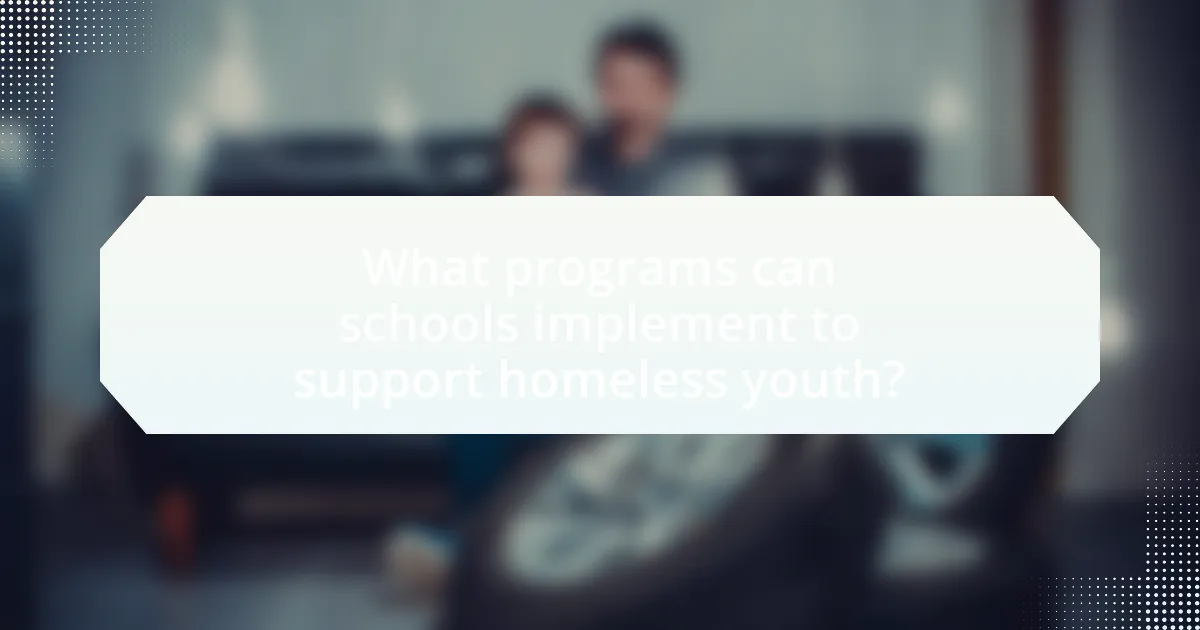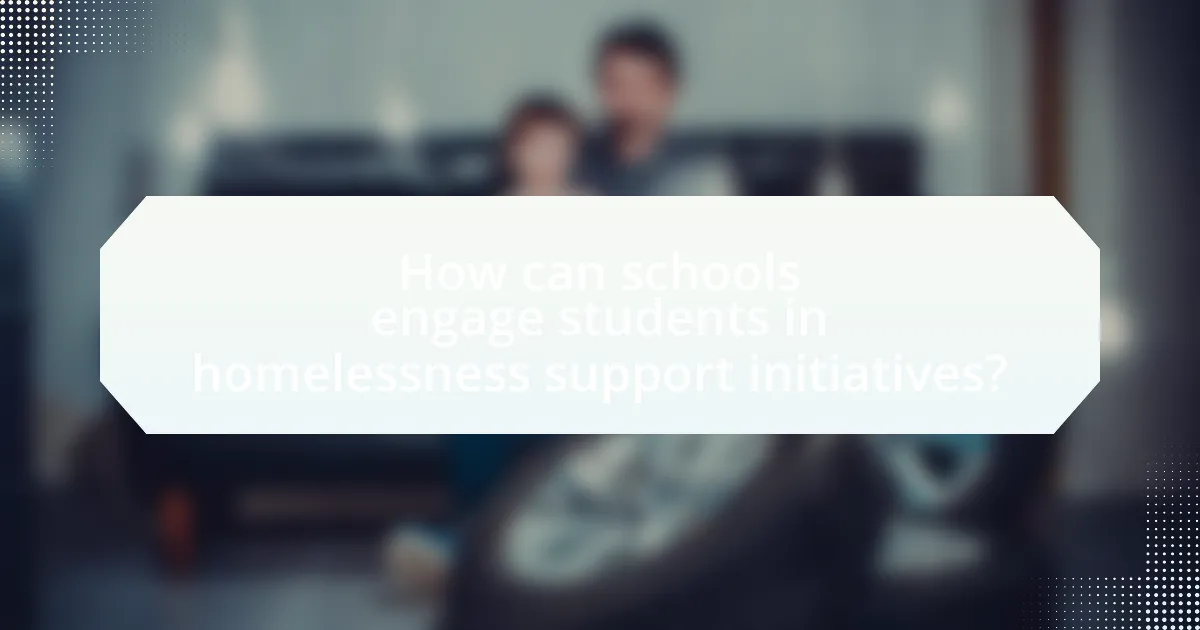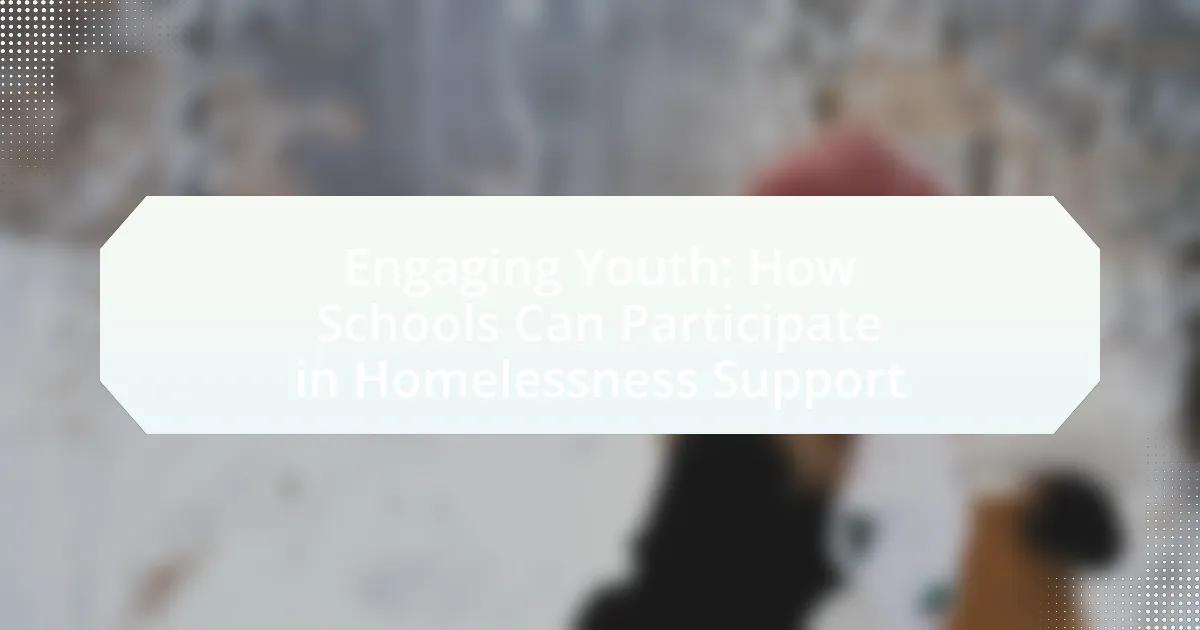The article focuses on the critical role schools play in supporting homeless youth, emphasizing the importance of providing access to education, resources, and a stable environment. It outlines how schools can identify homeless students, create welcoming environments, and implement essential support programs, such as counseling and food security initiatives. Additionally, the article discusses the impact of homelessness on education, the benefits of community partnerships, and effective strategies for engaging students in homelessness support initiatives. By addressing the unique challenges faced by homeless youth, schools can foster a more inclusive and supportive educational experience.

What is the role of schools in supporting homeless youth?
Schools play a crucial role in supporting homeless youth by providing access to education, resources, and a stable environment. They offer essential services such as counseling, food programs, and connections to community resources, which help address the immediate needs of homeless students. According to the National Center for Homeless Education, schools are required under the McKinney-Vento Homeless Assistance Act to ensure that homeless students have equal access to education and support services. This legal framework mandates that schools identify homeless students, provide transportation, and facilitate enrollment, thereby promoting educational stability and continuity for these vulnerable youth.
How can schools identify homeless students?
Schools can identify homeless students by implementing a systematic approach that includes training staff to recognize signs of homelessness, utilizing surveys to gather information from families, and collaborating with local agencies that assist homeless populations. Training staff helps them understand the indicators of homelessness, such as frequent absences, lack of stable housing, or behavioral issues. Surveys can be distributed at the beginning of the school year or during enrollment to collect data on housing stability. Collaboration with local agencies, such as shelters or social services, provides schools with resources and insights to identify and support homeless students effectively. According to the McKinney-Vento Homeless Assistance Act, schools are required to identify and support homeless students, ensuring they have access to education and necessary services.
What signs indicate a student may be experiencing homelessness?
Signs indicating a student may be experiencing homelessness include frequent absences from school, lack of appropriate clothing or personal hygiene, and signs of hunger or fatigue. Additionally, students may exhibit behavioral changes such as withdrawal, anxiety, or aggression. Research shows that homeless students often face instability, which can manifest in academic struggles and difficulty forming relationships with peers. According to the National Center for Homeless Education, approximately 1.5 million students in the U.S. experience homelessness each year, highlighting the prevalence of these signs in educational settings.
How can schools create a welcoming environment for homeless students?
Schools can create a welcoming environment for homeless students by implementing inclusive policies and providing essential resources. Establishing a designated support staff, such as a social worker or counselor, can help address the unique needs of homeless students, ensuring they feel safe and supported. Additionally, schools can offer access to basic necessities like food, clothing, and hygiene products, which are crucial for students facing homelessness.
Research indicates that schools with supportive environments see improved academic performance and emotional well-being among homeless students. For instance, a study by the National Center for Homeless Education found that students experiencing homelessness who received targeted support showed higher attendance rates and better engagement in school activities. By fostering a culture of acceptance and understanding, schools can significantly enhance the educational experience for homeless students.
Why is it important for schools to engage in homelessness support?
It is important for schools to engage in homelessness support because they play a critical role in the well-being and educational success of vulnerable students. Schools provide a stable environment and essential resources that can help mitigate the negative impacts of homelessness on academic performance and mental health. Research indicates that students experiencing homelessness are more likely to face challenges such as lower grades, higher dropout rates, and increased behavioral issues. By implementing support programs, schools can offer access to counseling, food, and academic assistance, which are vital for helping these students succeed. For instance, the National Center for Homeless Education reports that students experiencing homelessness are 87% more likely to drop out of school compared to their peers, highlighting the urgent need for targeted support within educational settings.
What impact does homelessness have on a student’s education?
Homelessness negatively impacts a student’s education by disrupting their stability, leading to lower academic performance and increased absenteeism. Students experiencing homelessness often face challenges such as lack of access to resources, unstable living conditions, and emotional distress, which hinder their ability to focus on learning. Research indicates that homeless students are twice as likely to repeat a grade and have lower test scores compared to their housed peers, highlighting the significant educational barriers they encounter.
How can supporting homeless youth benefit the school community?
Supporting homeless youth can significantly benefit the school community by fostering a more inclusive and empathetic environment. When schools provide resources and support for homeless youth, they promote social cohesion and reduce stigma, which enhances the overall school climate. Research indicates that schools with programs aimed at supporting homeless students see improved attendance and academic performance, as these students are more likely to engage when their basic needs are met. For instance, a study by the National Center for Homeless Education found that schools implementing support systems for homeless students reported a 20% increase in student engagement and a 15% improvement in academic outcomes. This not only aids the individual students but also enriches the educational experience for all students by cultivating a culture of understanding and support.

What programs can schools implement to support homeless youth?
Schools can implement programs such as emergency housing assistance, mental health services, and food security initiatives to support homeless youth. Emergency housing assistance programs provide temporary shelter and resources for students facing homelessness, ensuring they have a safe place to stay. Mental health services, including counseling and support groups, address the emotional and psychological challenges that homeless youth often encounter. Food security initiatives, such as free meal programs and food pantries, help alleviate hunger and ensure that students have access to nutritious meals, which is crucial for their academic success. These programs are essential as studies show that stable housing and access to mental health resources significantly improve educational outcomes for homeless youth.
How can schools create partnerships with local organizations?
Schools can create partnerships with local organizations by actively reaching out to community groups that focus on homelessness support and related services. This can involve organizing meetings to discuss mutual goals, sharing resources, and developing collaborative programs that benefit both students and the community. For instance, schools can partner with local shelters to provide students with volunteer opportunities, which not only aids the shelters but also educates students about homelessness. Research indicates that such partnerships can enhance student engagement and foster a sense of social responsibility, as seen in programs like the “Service Learning” initiatives that have shown positive outcomes in student involvement and community impact.
What types of organizations should schools collaborate with?
Schools should collaborate with local non-profit organizations, government agencies, and community service groups that focus on homelessness support. These organizations often provide resources, expertise, and programs that can directly benefit students experiencing homelessness. For instance, partnerships with local shelters can facilitate access to housing resources, while collaboration with food banks can ensure that students receive adequate nutrition. Research indicates that schools working with community organizations can improve educational outcomes for at-risk youth, as demonstrated by programs like the National School Lunch Program, which has been shown to reduce food insecurity among students.
How can these partnerships enhance support for homeless students?
Partnerships can enhance support for homeless students by providing comprehensive resources and services tailored to their unique needs. These collaborations often involve schools, local organizations, and community services, which can facilitate access to essential support such as housing assistance, mental health services, and academic tutoring. For instance, a study by the National Center for Homeless Education found that schools partnering with local shelters and food banks significantly improved attendance and academic performance among homeless students. By pooling resources and expertise, these partnerships create a more supportive environment that addresses both the immediate and long-term challenges faced by homeless students.
What resources can schools provide to assist homeless students?
Schools can provide various resources to assist homeless students, including access to counseling services, food programs, and transportation assistance. Counseling services help address emotional and psychological needs, while food programs ensure that students receive nutritious meals, which is critical for their health and academic performance. Transportation assistance facilitates access to school, enabling consistent attendance, which is essential for educational success. According to the National Center for Homeless Education, schools are required to provide support under the McKinney-Vento Homeless Assistance Act, which mandates that homeless students have equal access to education and related services.
What types of academic support are essential for homeless youth?
Essential academic support for homeless youth includes access to tutoring, mentorship programs, and stable learning environments. Tutoring provides personalized assistance to help students catch up on missed coursework, while mentorship programs connect youth with caring adults who can guide them academically and emotionally. Stable learning environments, such as schools that offer consistent attendance policies and resources like transportation and school supplies, are crucial for fostering educational engagement. Research indicates that these supports significantly improve academic outcomes for homeless youth, as they address both educational gaps and the emotional challenges associated with homelessness.
How can schools address the basic needs of homeless students?
Schools can address the basic needs of homeless students by implementing comprehensive support systems that include access to food, shelter, healthcare, and counseling services. For instance, schools can establish food pantries and provide free meals to ensure that students receive adequate nutrition, which is critical for their physical and mental well-being. Additionally, schools can collaborate with local shelters and community organizations to offer safe housing options and resources for families experiencing homelessness.
Healthcare services, including mental health support, can be integrated into school programs to address the emotional and psychological challenges faced by homeless students. According to the National Center for Homeless Education, over 1.5 million students experienced homelessness in the 2019-2020 school year, highlighting the urgent need for schools to create inclusive environments that cater to these students’ unique challenges. By fostering partnerships with local agencies and providing targeted resources, schools can effectively meet the basic needs of homeless students and promote their academic success.

How can schools engage students in homelessness support initiatives?
Schools can engage students in homelessness support initiatives by implementing service-learning programs that connect classroom learning with community service. These programs allow students to participate in activities such as organizing food drives, volunteering at shelters, or conducting awareness campaigns about homelessness. Research indicates that service-learning enhances students’ civic engagement and empathy, fostering a deeper understanding of social issues. For instance, a study by the National Youth Leadership Council found that students involved in service-learning demonstrate increased academic performance and a greater commitment to community service. By integrating these initiatives into the curriculum, schools can effectively motivate students to contribute to homelessness support while developing essential life skills.
What role can student organizations play in supporting homeless youth?
Student organizations can play a crucial role in supporting homeless youth by providing resources, advocacy, and community engagement. These organizations often organize food drives, clothing donations, and fundraising events specifically aimed at addressing the immediate needs of homeless youth. For instance, a study by the National Alliance to End Homelessness highlights that peer-led initiatives can effectively raise awareness and mobilize resources within the community. Additionally, student organizations can collaborate with local shelters and service providers to create mentorship programs, offering guidance and support to homeless youth as they navigate educational and employment opportunities. This multifaceted approach not only addresses the immediate needs of homeless youth but also fosters a sense of community and belonging, which is essential for their long-term well-being.
How can schools encourage student-led initiatives for homelessness awareness?
Schools can encourage student-led initiatives for homelessness awareness by providing resources, support, and platforms for students to express their ideas and take action. For instance, schools can establish clubs focused on social issues, such as homelessness, where students can collaborate on projects, organize events, and engage with local organizations. Additionally, incorporating service-learning into the curriculum allows students to connect classroom knowledge with real-world issues, fostering a sense of responsibility and empathy. Research shows that student-led initiatives can significantly increase awareness and community involvement, as evidenced by programs like “Homeless Awareness Week,” which have successfully mobilized students to advocate for change and support local shelters.
What are effective ways to involve students in community service related to homelessness?
Effective ways to involve students in community service related to homelessness include organizing volunteer opportunities at local shelters, conducting fundraising events for homeless support organizations, and implementing educational programs that raise awareness about homelessness. Research shows that hands-on experiences, such as serving meals or participating in clothing drives, foster empathy and social responsibility among students. For instance, a study by the Corporation for National and Community Service found that students who engage in community service are more likely to develop a lifelong commitment to civic engagement. Additionally, partnerships with local nonprofits can provide structured programs that enhance students’ understanding of homelessness and its complexities.
How can schools educate students about homelessness?
Schools can educate students about homelessness through comprehensive curriculum integration, community service projects, and awareness campaigns. By incorporating lessons on social issues, including the causes and effects of homelessness, students gain a deeper understanding of the topic. Research indicates that experiential learning, such as volunteering at local shelters, enhances empathy and social responsibility among youth. Additionally, awareness campaigns, such as hosting guest speakers from homeless advocacy organizations, can provide firsthand insights and foster discussions. These methods collectively equip students with knowledge and compassion, promoting a more informed and engaged generation regarding homelessness.
What topics should be covered in educational programs about homelessness?
Educational programs about homelessness should cover the causes of homelessness, the impact on individuals and communities, available resources and support systems, and ways to advocate for policy changes. Understanding the causes, such as economic factors, mental health issues, and systemic inequalities, provides a foundation for addressing homelessness effectively. The impact of homelessness on health, education, and social stability highlights the urgency of the issue. Knowledge of resources, including shelters, food banks, and counseling services, equips students to assist those in need. Finally, teaching advocacy skills empowers youth to engage in policy discussions and community initiatives aimed at reducing homelessness.
How can schools facilitate discussions on homelessness in the classroom?
Schools can facilitate discussions on homelessness in the classroom by integrating the topic into the curriculum through structured lessons and activities. Educators can use real-world case studies, statistics, and personal narratives to provide context and foster empathy among students. For instance, according to the National Alliance to End Homelessness, over 580,000 people experience homelessness in the U.S. on any given night, which can serve as a starting point for discussions. Additionally, schools can invite guest speakers from local shelters or organizations to share firsthand experiences, creating a more engaging and informative environment. By encouraging critical thinking and open dialogue, schools can help students understand the complexities of homelessness and inspire them to take action in their communities.
What are best practices for schools to support homeless youth effectively?
Schools can effectively support homeless youth by implementing comprehensive support systems that address their unique needs. These systems should include establishing a dedicated liaison or support staff trained in trauma-informed care, which helps create a safe and welcoming environment for students. Additionally, schools should provide access to essential resources such as food, clothing, and hygiene products, as well as mental health services to address emotional and psychological challenges faced by homeless youth.
Collaboration with local organizations and agencies can enhance support by connecting students with housing assistance and other community resources. Furthermore, schools should ensure that policies are in place to protect the rights of homeless students, including transportation assistance and enrollment flexibility, which are critical for maintaining educational stability. Research indicates that schools with such comprehensive support systems see improved attendance and academic performance among homeless students, highlighting the effectiveness of these practices.
How can schools measure the effectiveness of their support programs?
Schools can measure the effectiveness of their support programs by utilizing quantitative and qualitative assessments, including surveys, academic performance tracking, and attendance records. For instance, implementing pre- and post-program surveys can provide insights into students’ perceptions and experiences, while analyzing changes in academic performance and attendance rates can indicate the program’s impact on student engagement and success. Research shows that schools that regularly evaluate their support initiatives, such as through the use of standardized assessments and feedback mechanisms, can identify areas for improvement and demonstrate the effectiveness of their programs in addressing student needs, particularly in contexts like homelessness support.
What strategies can schools adopt to ensure sustainability in their support efforts?
Schools can adopt strategies such as establishing partnerships with local organizations, integrating service-learning into the curriculum, and creating student-led initiatives to ensure sustainability in their support efforts for homelessness. By collaborating with local shelters and nonprofits, schools can provide ongoing resources and support, ensuring that efforts are not isolated but part of a larger community framework. Integrating service-learning allows students to engage directly with the issues of homelessness, fostering empathy and a sense of responsibility while also providing practical assistance. Additionally, empowering students to lead initiatives encourages ownership and long-term commitment to the cause, making the support efforts more sustainable. These strategies collectively create a robust framework for ongoing engagement and support for homeless individuals in the community.

Leave a Reply